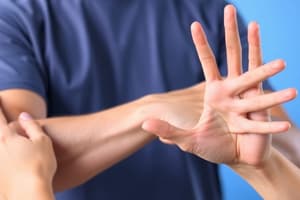Podcast
Questions and Answers
Olfactory receptors cells are located in a mucous membrane at the top of the ______
Olfactory receptors cells are located in a mucous membrane at the top of the ______
nose
Umami is our fifth ______
Umami is our fifth ______
taste
The vestibular sense contributes to our ability to maintain balance and body ______
The vestibular sense contributes to our ability to maintain balance and body ______
posture
The olfactory bulb is a bulb-like structure at the tip of the frontal ______
The olfactory bulb is a bulb-like structure at the tip of the frontal ______
The vestibular organs are fluid-filled and have hair cells, similar to the ones found in the ______ system
The vestibular organs are fluid-filled and have hair cells, similar to the ones found in the ______ system
Taste – you have learned since elementary school that there are four basic groupings of taste: sweet, salty, sour, and ______
Taste – you have learned since elementary school that there are four basic groupings of taste: sweet, salty, sour, and ______
Sensory motor control is best thought of as a complex, highly integrated process involving thousands of ensembles of sensory information from the periphery that are processed by a network of neurons, interneurons, and CNS centers that use an equally complex system of pathways and neurons to activate muscles and produce coordinated movement. The process of processing sensory signals (sensory input) and generating a response is referred to as sensory-motor skills (motor output). Our sensory systems (vision, hearing, smell, taste, touch, vestibular, and ______) receive sensory input from our bodies and the environment.
Sensory motor control is best thought of as a complex, highly integrated process involving thousands of ensembles of sensory information from the periphery that are processed by a network of neurons, interneurons, and CNS centers that use an equally complex system of pathways and neurons to activate muscles and produce coordinated movement. The process of processing sensory signals (sensory input) and generating a response is referred to as sensory-motor skills (motor output). Our sensory systems (vision, hearing, smell, taste, touch, vestibular, and ______) receive sensory input from our bodies and the environment.
COMPONENTS OF SENSORY-MOTOR CONTROL Vision – the sense associated with the visual sensory system. Touch – the detection of specific characteristics of the object, person, or environment through tactile sensory receptors in our skin that are part of our somatic sensory system. When we touch something, mechanoreceptors in the skin activate to provide the CNS with information related to pain, temperature and movement. There are five movement-related characteristics influenced by tactile sensory information that the CNS receives from touch; Movement accuracy; Movement consistency; Movement timing; Movement force adjustments and; Estimate movement distance. ______ – the sensation and perception of limb, trunk and head position and movement.
COMPONENTS OF SENSORY-MOTOR CONTROL Vision – the sense associated with the visual sensory system. Touch – the detection of specific characteristics of the object, person, or environment through tactile sensory receptors in our skin that are part of our somatic sensory system. When we touch something, mechanoreceptors in the skin activate to provide the CNS with information related to pain, temperature and movement. There are five movement-related characteristics influenced by tactile sensory information that the CNS receives from touch; Movement accuracy; Movement consistency; Movement timing; Movement force adjustments and; Estimate movement distance. ______ – the sensation and perception of limb, trunk and head position and movement.
Sensory motor control is best thought of as a complex, highly integrated process involving thousands of ensembles of sensory information from the ______ that are processed by a network of neurons, interneurons, and CNS centers that use an equally complex system of pathways and neurons to activate muscles and produce coordinated movement.
Sensory motor control is best thought of as a complex, highly integrated process involving thousands of ensembles of sensory information from the ______ that are processed by a network of neurons, interneurons, and CNS centers that use an equally complex system of pathways and neurons to activate muscles and produce coordinated movement.
The process of processing sensory signals (sensory input) and generating a response is referred to as sensory-motor skills (motor output). Our sensory systems (vision, hearing, smell, taste, touch, vestibular, and proprioception) receive sensory input from our bodies and the ______.
The process of processing sensory signals (sensory input) and generating a response is referred to as sensory-motor skills (motor output). Our sensory systems (vision, hearing, smell, taste, touch, vestibular, and proprioception) receive sensory input from our bodies and the ______.
Touch – the detection of specific characteristics of the object, person, or environment through tactile sensory receptors in our skin that are part of our somatic sensory system. When we touch something, mechanoreceptors in the skin activate to provide the CNS with information related to pain, temperature and ______.
Touch – the detection of specific characteristics of the object, person, or environment through tactile sensory receptors in our skin that are part of our somatic sensory system. When we touch something, mechanoreceptors in the skin activate to provide the CNS with information related to pain, temperature and ______.
There are five movement-related characteristics influenced by tactile sensory information that the CNS receives from touch; Movement accuracy; Movement consistency; Movement timing; Movement force adjustments and; Estimate movement ______.
There are five movement-related characteristics influenced by tactile sensory information that the CNS receives from touch; Movement accuracy; Movement consistency; Movement timing; Movement force adjustments and; Estimate movement ______.
Flashcards are hidden until you start studying




